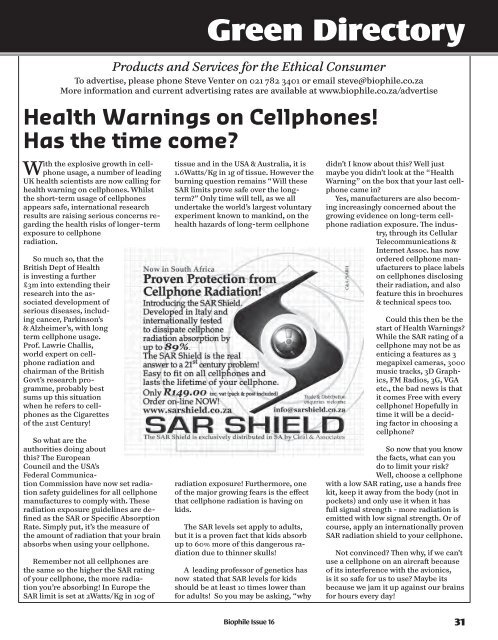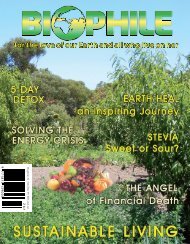BIOPHILE 16 â JUNE/JULY 2007 R25 - Biophile Magazine
BIOPHILE 16 â JUNE/JULY 2007 R25 - Biophile Magazine
BIOPHILE 16 â JUNE/JULY 2007 R25 - Biophile Magazine
- No tags were found...
Create successful ePaper yourself
Turn your PDF publications into a flip-book with our unique Google optimized e-Paper software.
Green DirectoryProducts and Services for the Ethical ConsumerTo advertise, please phone Steve Venter on 021 782 3401 or email steve@biophile.co.zaMore information and current advertising rates are available at www.biophile.co.za/advertiseHealth Warnings on Cellphones!Has the time come?With the explosive growth in cellphoneusage, a number of leadingUK health scientists are now calling forhealth warning on cellphones. Whilstthe short-term usage of cellphonesappears safe, international researchresults are raising serious concerns regardingthe health risks of longer-termexposure to cellphoneradiation.So much so, that theBritish Dept of Healthis investing a further£3m into extending theirresearch into the associateddevelopment ofserious diseases, includingcancer, Parkinson’s& Alzheimer’s, with longterm cellphone usage.Prof. Lawrie Challis,world expert on cellphoneradiation andchairman of the BritishGovt’s research programme,probably bestsums up this situationwhen he refers to cellphonesas the Cigarettesof the 21st Century!So what are theauthorities doing aboutthis? The EuropeanCouncil and the USA’sFederal CommunicationCommission have now set radiationsafety guidelines for all cellphonemanufactures to comply with. Theseradiation exposure guidelines are definedas the SAR or Specific AbsorptionRate. Simply put, it’s the measure ofthe amount of radiation that your brainabsorbs when using your cellphone.Remember not all cellphones arethe same so the higher the SAR ratingof your cellphone, the more radiationyou’re absorbing! In Europe theSAR limit is set at 2Watts/Kg in 10g oftissue and in the USA & Australia, it is1.6Watts/Kg in 1g of tissue. However theburning question remains “ Will theseSAR limits prove safe over the longterm?”Only time will tell, as we allundertake the world’s largest voluntaryexperiment known to mankind, on thehealth hazards of long-term cellphoneradiation exposure! Furthermore, oneof the major growing fears is the effectthat cellphone radiation is having onkids.The SAR levels set apply to adults,but it is a proven fact that kids absorbup to 60% more of this dangerous radiationdue to thinner skulls!A leading professor of genetics hasnow stated that SAR levels for kidsshould be at least 10 times lower thanfor adults! So you may be asking, “whydidn’t I know about this? Well justmaybe you didn’t look at the “HealthWarning” on the box that your last cellphonecame in?Yes, manufacturers are also becomingincreasingly concerned about thegrowing evidence on long-term cellphoneradiation exposure. The industry,through its CellularTelecommunications &Internet Assoc. has nowordered cellphone manufacturersto place labelson cellphones disclosingtheir radiation, and alsofeature this in brochures& technical specs too.Could this then be thestart of Health Warnings?While the SAR rating of acellphone may not be asenticing a features as 3megapixel cameras, 3000music tracks, 3D Graphics,FM Radios, 3G, VGAetc., the bad news is thatit comes Free with everycellphone! Hopefully intime it will be a decidingfactor in choosing acellphone?So now that you knowthe facts, what can youdo to limit your risk?Well, choose a cellphonewith a low SAR rating, use a hands freekit, keep it away from the body (not inpockets) and only use it when it hasfull signal strength - more radiation isemitted with low signal strength. Or ofcourse, apply an internationally provenSAR radiation shield to your cellphone.Not convinced? Then why, if we can’tuse a cellphone on an aircraft becauseof its interference with the avionics,is it so safe for us to use? Maybe itsbecause we jam it up against our brainsfor hours every day!<strong>Biophile</strong> Issue <strong>16</strong>31
















